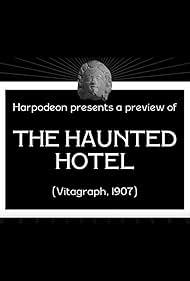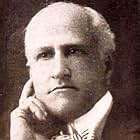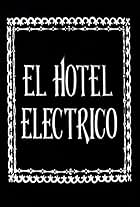On a dark and stormy night, a traveler takes a room at a spooky hotel in the forest. As soon as the proprietor leaves, the room comes alive with ghosts and poltergeists who torment the man a... Read allOn a dark and stormy night, a traveler takes a room at a spooky hotel in the forest. As soon as the proprietor leaves, the room comes alive with ghosts and poltergeists who torment the man as he tries to unpack, eat, and go to sleep.On a dark and stormy night, a traveler takes a room at a spooky hotel in the forest. As soon as the proprietor leaves, the room comes alive with ghosts and poltergeists who torment the man as he tries to unpack, eat, and go to sleep.
- Director
- Stars
Featured reviews
At the beginning of this Vitagraph Company short film (five and one-half minutes) we see, not a hotel, but a cottage that is a small country inn. Perhaps in the early 20th century such inns were called hotels. In any case, the inn immediately mutates into a scary face. In the next scene we are inside the inn, where a traveler enters with his baggage. The traveler is very creepy looking with his craggy-looking face and Pinocchio nose. Before long, items such as baggage and cloth napkins are moving by themselves. Dinner prepares itself. A knife cuts a sausage in two, and also slices a loaf of bread. A beverage (ale?) pours itself into a mug, and then a pot of coffee pours into a cup. A tiny clown departs the pot.
At bedtime the weary traveler's problems really begin. For one thing, the furniture moves, then the house tilts. Ghosts dance around the bed. At the end, a wall disappears and an awful demon of mammoth size appears in back of the bed and snatches into his huge hand the traveler along with his blanket. The film is more terrifying than comical (especially for the young), but still enjoyable. Taking pleasure in this film certainly does not detract from the works of Georges Melies, who made "The Bewitched Inn" in 1897.
At bedtime the weary traveler's problems really begin. For one thing, the furniture moves, then the house tilts. Ghosts dance around the bed. At the end, a wall disappears and an awful demon of mammoth size appears in back of the bed and snatches into his huge hand the traveler along with his blanket. The film is more terrifying than comical (especially for the young), but still enjoyable. Taking pleasure in this film certainly does not detract from the works of Georges Melies, who made "The Bewitched Inn" in 1897.
The Haunted Hotel (1907)
**** (out of 4)
This film from Vitagraph is obviously one of the dozens (if not hundreds) of Georges Melies rip-offs but this one here is actually a mini-masterpiece. There appear to be many films with this title that were released around this time so this leads to some confusion about what people are actually seeing. The film (subtitled The Strange Adventures of a Traveler) here starts with a close up shot of a table with items like a loaf of bread, coffee and a few other things. Out of nowhere these items come to life. Melies was a master at the trick film but I must admit that this thing here is a masterpiece and it really is a complete joy to watch. Clocking in at just over a minute, the film manages to be quite thrilling through every second of that. I think the greatest moment in the film is the sequence where a knife comes up and starts cutting the break into pieces. It's just amazing to see this scene play out because it's very hard and nearly impossible to see how the effect was done. Director J. Stuart Blackton does a remarkable job at keeping everything flowing and there's no question that you really do get a haunted feeling while watching everything that happens.
**** (out of 4)
This film from Vitagraph is obviously one of the dozens (if not hundreds) of Georges Melies rip-offs but this one here is actually a mini-masterpiece. There appear to be many films with this title that were released around this time so this leads to some confusion about what people are actually seeing. The film (subtitled The Strange Adventures of a Traveler) here starts with a close up shot of a table with items like a loaf of bread, coffee and a few other things. Out of nowhere these items come to life. Melies was a master at the trick film but I must admit that this thing here is a masterpiece and it really is a complete joy to watch. Clocking in at just over a minute, the film manages to be quite thrilling through every second of that. I think the greatest moment in the film is the sequence where a knife comes up and starts cutting the break into pieces. It's just amazing to see this scene play out because it's very hard and nearly impossible to see how the effect was done. Director J. Stuart Blackton does a remarkable job at keeping everything flowing and there's no question that you really do get a haunted feeling while watching everything that happens.
This sort of trick film, in which a traveler goes some place where things mysteriously happen, was not new when J. Stuart Blackton made it in 1907. Melies was making stuff like it in 1896, and the vim and verve of his performances was a lot better than the actor's here.
Nonetheless, there was a change and advance in the decade and it was in the evolution of a film grammar. In the earlier films, the point of the transformations, appearances, disappearances and things moving on their own was that they were happening. They were the point of the movie and any actor on the screen stood in for the goggling audience. It was a magic act.
This film, however, is more than that. It is a story about a traveler who checks into a hotel and the weird and terrifying things that happen to him. The things that happen -- knives that cut sausage without anyone holding them -- are not the point of the movie, they are means of achieving the point. They have moved from simple shots to film vocabulary.
The vocabulary would remain the same, even though the grammar they exist in -- a cobbled-together pidgin of stage, magic lantern and ad hoc film usage -- would be swept away within half a decade. However, the next time you look at a horror movie, take a look. They're still using the same tricks.
Nonetheless, there was a change and advance in the decade and it was in the evolution of a film grammar. In the earlier films, the point of the transformations, appearances, disappearances and things moving on their own was that they were happening. They were the point of the movie and any actor on the screen stood in for the goggling audience. It was a magic act.
This film, however, is more than that. It is a story about a traveler who checks into a hotel and the weird and terrifying things that happen to him. The things that happen -- knives that cut sausage without anyone holding them -- are not the point of the movie, they are means of achieving the point. They have moved from simple shots to film vocabulary.
The vocabulary would remain the same, even though the grammar they exist in -- a cobbled-together pidgin of stage, magic lantern and ad hoc film usage -- would be swept away within half a decade. However, the next time you look at a horror movie, take a look. They're still using the same tricks.
J. Stuart Blackton, the pioneering animator, upped his game in 1907's "The Haunted Hotel." With each new project, Blackton continued to invent innovative ways to manipulate objects. In this film he used several George Melies' tricks--double exposures, stop camera substitutions-- and added several of his newer inventions to stop-motion and invisible wire special effects. Later animators would study this movie to see how Blackton achieved such mind-blowing visuals. As someone else on this board said, the teapot scene had been copied by Disney in the 1991 "Beauty And The Beast." The ending of Haunted House is not to be missed.
Some pretty cool stop motion effects in the animated tea party, transparent ghosts dancing maniacally, and other visual tricks from director J. Stuart Blackton. That giant demon at the end is a nice touch too.
Did you know
- ConnectionsFeatured in Cartoon Carnival (2021)
Details
- Release date
- Country of origin
- Language
- Also known as
- The Haunted Hotel; or, The Strange Adventures of a Traveler
- Production company
- See more company credits at IMDbPro
- Runtime5 minutes
- Color
- Sound mix
- Aspect ratio
- 1.33 : 1
Contribute to this page
Suggest an edit or add missing content















